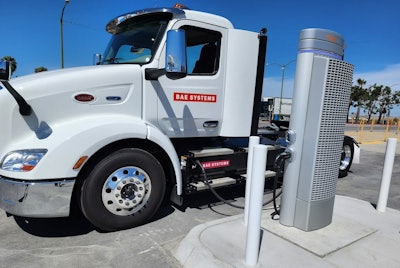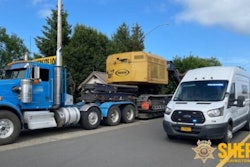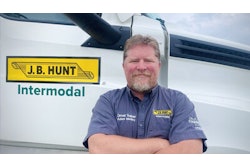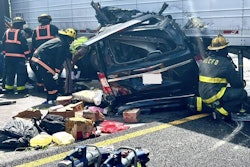
Members of a trucking organization this week told government officials that regulations aimed at forcing the freight industry to reduce or eliminate emissions do not take into account what it will take to create a nationwide charging system to support heavy-duty battery-electric vehicles.
On Thursday, leaders from the Clean Freight Coalition met with officials from the Joint Office of Energy and Transportation to discuss the challenges and opportunities of transitioning the nation's commercial truck fleet to low- and zero-emission vehicles. The first meeting between CFC and the Joint Office comes as emerging state and federal regulations aim to push the transportation sector toward decarbonization, according to a statement from the coalition.
The Joint Office was created through the Bipartisan Infrastructure Law to facilitate collaboration between the Departments of Energy and Transportation on deploying a network of electric vehicle chargers and zero-emission fueling infrastructure. As an alliance of freight transportation stakeholders committed to a zero-emission future, the CFC was launched in March to educate policymakers on these issues.
During Thursday's meeting, the CFC urged the Joint Office to consider the heavy-duty sector when granting federal funds. The CFC said what it called "a massive infrastructure gap" as one of the largest hurdles to a seamless transition away from carbon-based fuels — one that policymakers need to focus on now, says the CFC.
RELATED NEWS: Battery charging facility for heavy-duty trucks opens in Long Beach
"One of the fatal flaws in California's electric-truck mandates is that the infrastructure buildout is lightyears behind the hyper-aggressive timelines set forth in regulation," said CFC Executive Director Jim Mullen.
"By trying to force the trucking industry to electrify without the charging infrastructure and power capacity that will be required, the state is setting trucking and the supply chain up for failure. That's why in our meeting with the Joint Office today we stressed why EPA should not propose ZEV-dependent rules prior to ensuring the necessary resources are actually in place."
In order to realize the scalable deployment of medium- and heavy-duty battery-electric trucks envisioned by EPA’s GHG3 rulemaking, 15,625 chargers would have to be installed every month between now and 2032, according to a Ricardo Strategic Consulting analysis prepared for the Truck and Engine Manufacturers Associations in June. To date, no state has directed any National Electric Vehicle Infrastructure (NEVI) grant program funds to medium- and heavy-duty charging infrastructure, according to a statement from the coalition.
For charging to be compatible with complex truck driving schedules, charging will have to take place at existing truck parking locations along interstate routes, yet the industry already faces a chronic, nationwide shortage of commercial truck parking, said a statement from the CFC.
A number of trucking industry leaders weighed in on the issue. They included:
- Dan Van Alstine, chairman of the American Trucking Associations and President and Chief Operating Officer at Ruan Transportation Management Systems."We need to get this right, which frankly the consequences are too great. It's critical that any regulatory framework is connected to the realities of trucking operations. That is the key to success, and that is why we are here in Washington having these conversations today.”
- Scott McCandless, chairman of the American Truck Dealers “The trucking industry needs adequate lead times across all market segments to ensure these vehicles are affordable and supported by the necessary infrastructure. It is troubling that government is pushing the regulation of zero-emission vehicles in a way that could slow down rather than accelerate the adoption by truck customers.”
- Andy Richard, chief executive officer of Sapp Bros. “Policies shouldn’t ignore the lower-carbon fuels that are at our disposal today. A market-driven, technology-neutral approach will advance the adoption of alternative fuels without picking winners and losers. Biodiesel and renewable diesel represent the best option that fleets have today to reduce their carbon emissions, and this will be the case for the foreseeable future. The right policies will encourage fuel retailers to make these investments without sacrificing efforts on electrification, hydrogen or other next-generation fuels."
- Jim Ward, president of the Truckload Carriers Association “The ‘essentiality’ of trucking to the supply chain became quite obvious during the pandemic. and our members remain committed to keeping America moving. To continue providing the quality of service the general public has come to expect, motor carriers must have reliable, affordable, and safe equipment available to them.”
- Ryan Streblow, president and CEO of the National Tank Truck Carriers. “The entire transportation ecosystem is at risk. The tank truck industry envisions low and zero-emission commercial trucks, but current timelines and goals must account for technology availability, affordability, infrastructure overall, and a scalable energy source.”
- Debbie Sparks, executive director of the National Motor Freight Traffic Association. “NMFTA stands with our industry peers to amplify our concerns and needs for more effective solutions."
The CFC also met with several lawmakers on Capitol Hill to discuss concerns over EPA’s GHG3 rulemaking and to urge repeal of the federal excise tax, which would provide dramatic and immediate emissions reductions by helping turnover the nation's aging truck fleet with today’s cleaner and safer models:










